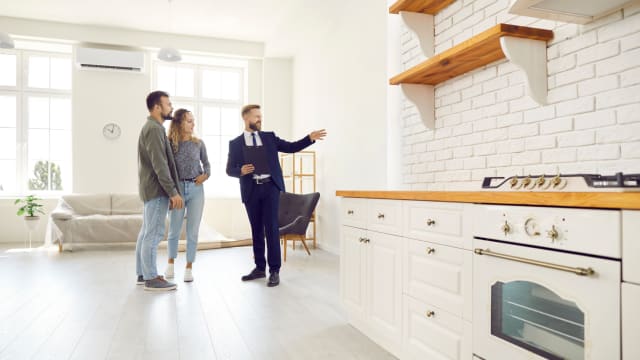What Is a Loft and Why You Might Want One
Introduction
As you start your apartment hunting journey, you’ll soon realize the world is filled with a variety of rental options, each with its unique charm and set of challenges. Among these, loft apartments have emerged as a favored choice for the modern renter, especially for those in search of something beyond the traditional living space.
If you’re considering a move into one of these open-concept, high-ceilinged havens, understanding the benefits of loft living and how to choose the perfect loft apartment can make all the difference in finding a space that not only meets your needs but also enhances your lifestyle.
What Is a Loft?

Originating from renovated industrial buildings, lofts are the epitome of urban living with a twist. They boast an open floor plan, soaring ceilings, and often, a mix of raw materials like exposed brick, concrete floors, and visible ductwork. This architectural cocktail serves up a living space that’s not just spacious but also brimming with character.
When pitted against traditional apartments, lofts stand out starkly. The typical apartment compartmentalizes life into neatly defined rooms, each with a specific purpose and standard ceiling heights that maintain a cozy, yet sometimes cramped, atmosphere.
Lofts, on the other hand,revel in open floor plans that allow living areas to flow into one another under the watchful eyes of high ceilings. This openness fosters a sense of freedom and creativity, making lofts a canvas awaiting personalization.
Pros and Cons of Renting a Loft
Loft living, with its unique blend of space and style, offers an intriguing alternative to conventional apartments. However, as with any abode, it comes with its own set of perks and quirks. Let’s explore some of the highs and lows, shall we?
The Upside: A Canvas of Possibilities
First off, the architectural allure of lofts cannot be overstated. Those high ceilings contribute to a sense of spaciousness and freedom that’s hard to find in standard apartments. Imagine the natural light flooding in through the large windows, casting a warm glow over an open, airy living space. It’s like living in your own personal art gallery, where the art is your life.
Lofts are a dream come true for the creatively inclined. With the open floor plan, you’re given a blank canvas to express your style. The raw, industrial elements like exposed brick and concrete floors add character and a modern edge that’s ripe for personalization.
The Downside: Living in a Fishbowl
Now, let’s talk about the downsides. The very features that give lofts their charm can also present challenges. The open floor plan, while spacious, offers limited privacy. It’s all fun and games until you realize your entire living area is visible from nearly every corner of your home. This layout can be particularly tricky for those who entertain guests often or live with roommates.
If you have a cluttered space, it can be hard to hide.
Noise can be another issue. Without walls to contain sound, every phone call, movie night, or midnight snack becomes a shared experience. This can be a deal-breaker for light sleepers or those who work from home and need quiet during the day.
And then there’s the climate control conundrum. Those tall ceilings and large windows that we love? They can make heating or cooling your loft an epic saga, especially in extreme weather. It’s not uncommon for loft dwellers to invest in extra fans, space heaters, or even consider innovative insulation solutions to keep their space comfortable year-round.
Lofts for Different Lifestyles
Loft living isn’t a one-size-fits-all affair. It caters to a myriad of lifestyles, each finding unique ways to harness the openness and versatility of the space. Let’s meet a few personas who have made lofts their sanctuary and see how these spaces adapt to their needs.
The Artist: For the creatively inclined, a loft is a dream studio. The Artist thrives in the expansive, naturally lit space that a loft provides, where the high ceilings are not just a feature but a necessity for large canvases or sculptures. By using mobile dividers or shelves filled with supplies, The Artist can easily create a multifunctional area that serves as a studio by day and a cozy retreat by night.
The Remote Worker: In a world where working from home has become the new norm, The Remote Worker finds the loft to be an ideal setup. The key here is the strategic use of the space to create a dedicated and inspiring workspace. Think of a corner by a large window for a desk with an expansive view, promoting productivity and creativity. Acoustic panels can help manage sound, and smart storage solutions keep work materials accessible but out of sight when it’s time to relax.
The Social Butterfly: For those who love to entertain, the loft’s open floor plan is perfect for hosting gatherings, from intimate dinner parties to larger social events. The Social Butterfly utilizes modular furniture that can be rearranged to suit the occasion, from a cozy seating area for movie nights to a spacious setting for a cocktail party. Innovative lighting solutions help zone the space and set the mood, while the kitchen area becomes a central hub for guests to mingle.
Effectively Utilizing Open Space: Regardless of your lifestyle, making the most out of a loft’s open space requires creativity and planning. Here are some suggestions:
- Zoning: Use rugs, furniture, and lighting to define different areas without the need for walls. This can help separate living, working, and sleeping spaces.
- Vertical Space: Don’t forget to look up. High ceilings mean you can use vertical space for storage or even a mezzanine level, adding another layer to your living area.
- Flexibility: Opt for furniture that can serve multiple purposes or be easily moved. This allows you to adapt the space to your current needs, whether it’s creating a quiet reading nook or making room for a yoga session.
- Personal Touch: Finally, infuse your personality into the space. Lofts offer a unique opportunity to express your style, whether it’s through bold art pieces, vibrant textiles, or an eclectic mix of furniture.
In essence, a loft can be whatever you need it to be, adapting and transforming along with the rhythms of your life. Whether you’re an artist painting in the soft light of morning, a remote worker enjoying the calm of a well-organized space, or a social butterfly hosting memorable gatherings, a loft provides the backdrop to a life well-lived.
Financial Considerations

When considering a move to a loft, it’s crucial to weigh the financial implications against other types of apartments. Lofts, with their unique charm and spacious layouts, often come with a price tag that reflects their desirability.
Renting a loft can be more expensive than a traditional apartment or studio due to the premium placed on space and the architectural features that define lofts. The cost can vary significantly based on location, size, and the level of luxury the loft offers. For instance, in major cities where real estate is at a premium, loft rentals can command prices well above those of comparable one-bedroom apartments.
To give you a clearer picture, let’s break down the average costs in a few major cities:
- New York City: Lofts in trendy neighborhoods like SoHo or Tribeca can range from $4,000 to over $10,000 per month, depending on size and amenities.
- San Francisco: In this tech hub, lofts average about $3,500 to $7,000 per month, with prime locations attracting higher prices.
- Chicago: Lofts in the Windy City offer a bit more affordability, with prices ranging from $1,500 to $4,000 per month, especially in areas like the West Loop or South Loop.
While the sticker shock may be real, it’s important to consider the long-term financial benefits of loft living. For one, lofts in revitalized neighborhoods often appreciate in value faster than traditional apartments, potentially offering a solid investment should you decide to buy.
Additionally, some areas offer tax incentives for living in historically industrial or underdeveloped areas undergoing revitalization, which can include loft conversions. These benefits can offset the higher initial costs and contribute to a more favorable financial outlook over time.
Practical Tips and Recommendations
Finding the right loft can feel like a thrilling treasure hunt, but it’s not without its challenges. To snag a loft that ticks all your boxes, keep an eye out for a few key features.
High ceilings and large windows are a given, but don’t overlook the importance of efficient heating and cooling systems, sound insulation, and a location that balances the buzz of city life with your need for peace and quiet.
If you’re looking to sprinkle a little magic into your loft’s layout and design, check out our guide to blending the vintage aesthetic with a modern rental.
Now, let’s talk about making the most of your loft’s spacious layout. Strategic product choices can not only enhance your living experience but also keep your space feeling organized and looking stunning:
-
Stylish Room Dividers: For creating private spaces in an open-concept loft, consider adding stylish room dividers. They offer a flexible solution to partition your space without the need for construction, and they come in a variety of designs that can complement your loft’s aesthetic.
-
Smart Storage Solutions: Maximizing space without compromising the loft’s aesthetic is crucial. Look for smart storage solutions that blend functionality with style. From floating shelves that leverage vertical space to multifunctional furniture with hidden compartments, they can help keep clutter at bay.
Find Your Loft
It’s easy to see why a loft is such a compelling choice for many renters. If the idea of living in a loft excites you, our AI-powered apartment-finding platform is the perfect tool to help you find one that suits your taste and needs.
Tailor your search with our advanced filters to find the loft that not only meets your criteria but also inspires your creativity. Start your search now and discover the loft that’s waiting to be your next home.
FAQs
Q: How do I deal with noise in a loft?
A: Noise can be a significant concern in loft spaces due to the open floor plan and high ceilings. To mitigate this, consider investing in acoustic panels or heavy drapes that can absorb sound. Rugs and soft furnishings also help reduce echo.
Q: What are some ways to optimize the use of open spaces in a loft?
A: To make the most of your loft’s open space, think about zoning. Use furniture, rugs, and lighting to define different areas for dining, sleeping, and living. Consider flexible furniture that can be easily moved or adapted to suit your needs, like foldable tables or modular sofas.
Q: How can living in a loft impact my work-life balance, especially as a remote worker?
A: Lofts can offer an inspiring and spacious environment for remote work, but the lack of defined rooms can sometimes blur the lines between work and relaxation. To maintain a healthy work-life balance, create a dedicated workspace, preferably near natural light. Establish clear boundaries for work hours and ensure your setup is comfortable and ergonomically sound. At the end of the workday, physically closing your laptop or covering your workspace with a decorative screen can signal the shift from work mode to relaxation, helping to maintain that all-important balance.
Q: Can I make a loft feel cozy despite its industrial features?
A: Absolutely! The key to adding warmth to a loft’s industrial charm is layering textures and incorporating personal touches. Soft textiles like throws, cushions, and area rugs can add warmth and comfort. Warm lighting, from floor lamps to string lights, can create a cozy ambiance. Lastly, fill your space with items that reflect your personality, such as artwork, photos, and plants, to make your loft feel like home.
Q: Is it difficult to heat or cool a loft?
A: Due to their high ceilings and large windows, lofts can present challenges in maintaining consistent temperatures. In winter, consider using thermal curtains to insulate windows and investing in a high-quality area rug to retain heat. In summer, ceiling fans can promote air circulation, and portable air conditioning units can provide targeted cooling. Smart thermostats can also help manage energy usage by adjusting temperatures based on your schedule.

![What Is a Condo? [2024]](https://res.cloudinary.com/apartmentlist/image/fetch/c_fill,dpr_auto,f_auto,g_center,h_360,q_auto,w_640/https://images.ctfassets.net/q131gehs2pma/1gg40VIdLWi0N6ArHFJMWF/b7ee01a385db29957daf0aaacbefa24a/anv__33_.png)


